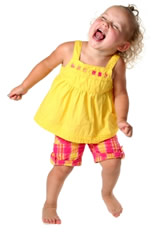
 Brain Dance
Brain DanceWhat do we know about dance, movement and learning?
How dance and movement help children experience their world.
Research tells us that in children from birth to age six a lot of important learning happens and neural connections are made at a very fast rate.
During this early learning period, children show us the many ways that they naturally and competently explore their world and approach learning. They hear, taste, see, move through and feel their world. As Einstein shared, "Learning is Experience" and early educators should pay attention to these natural learning experiences.
One important way children explore and learn about their world is through physical movement. Movement is a way for children to express themselves, particularly if they have not yet developed verbal language. As educators, we need to not only support movement as a learning tool, but embrace it.
Clues that learning is supported by movement, exercise, and dance
There is growing evidence to show that exercise benefits cognitive functions. Exercise increases blood flow to the brain, which is shown to help with memory and concentration. Physical activity is also said to help use pent-up energy, allowing children to focus better.
Children love activities that involve the senses and movement. Therefore, children are more attentive, which may heighten the learning experience at hand. In addition, physical activity simply makes children feel good and feeling good helps children not only with learning, but with self-confidence and an overall positive outlook.
Studies suggest that not only is dancing an artistic and athletic experience, but a learning experience as well. There is also the suggestion that early exposure to dance may enhance the link between observing and physical learning.
In order to dance and move, our bodies and our brains must engage the muscles and the actions themselves. Dance can combine learning methods such as learning by observing and learning by doing, which leads some to believe that exposure to dance enhances cognitive learning. Dance helps develop attention skills and strategies for memory retrieval that may also apply to other areas of learning.
Learning dance techniques helps children become aware of their physical presence, spatial relationships, self control, balance, intention, breathing, and pattern. Dancing moves your body up, down, backwards, and forwards and incorporates large, sweeping physical movements.
As children practice moving their bodies–arms, legs, hands, feet--in all directions, they start to gain a sense of the space around them, as well as how they can control their movements in that space.
Incorporating movement and dance in your program
You can support children's complex developmental skills by rethinking your day's activities to include more plans for dance, movement, and exercise, such as the following:
- Use dance and movement for transition times – dance like a ballerina to the
bathroom, dance like slithering snakes to the coat cubby, etc.
- Use movements to tell a story – when telling stories, use physical actions and
encourage the children to act out the story with you.
- Provide meaningful chores for children that include dancelike movements -
sweep the floor, take out the garbage, weed the gardens, and of course, clean
up the toys.
- Dance with only one part of your body – try dancing with only your hands,
arms, fingers, or head.
- Dance with multiple materials - dance with balls made of different sensory
materials (soft, rough, textured, etc.). Dance with brooms, stuffed animals,
scarves, and baskets. Also try dancing with things children can push and
move, like wheelbarrows and baby strollers. Have children stuff pillowcases
with towels and use these to move and dance with.
- Dance like me, dance like you – play "follow the leader" type activities, where
children take turns showing their dance move for others to try. Also try adding
simple patterns and steps for children to try.
- Swing and swim – use cross-lateral movements, where the opposite arm
moves at the same time as the opposite leg. Encourage children to walk as
they swing their arms, and pretend to play baseball and tennis. Pretend to be
swimming and do the different strokes.
- With infants - dance cheek to cheek and describe the movements – "I'm lifting
you up and turning around." Also provide time on the tummy.
- Sound out the dance - move with things that make sound, such as Velcro
bands of bells attached to wrists and ankles (uses multi-sensory actions) or
shaker-type instruments. Try taping flat, metal lids (recycled from juice cans,
etc.) to the bottom of shoes for fun tap dance sounds.
- Dance and draw – dance and draw shapes by using your body parts to be the pencil or use streamers to make shapes and letters. Also show drawings and pictures of shapes for children to look at first and then make with their bodies.
© 2010 - All rights reserved
Care For Kids Internet Services Pty Ltd
ABN 55 104 145 735
PO Box 543 Balmain NSW 2041
privacy policy contact us